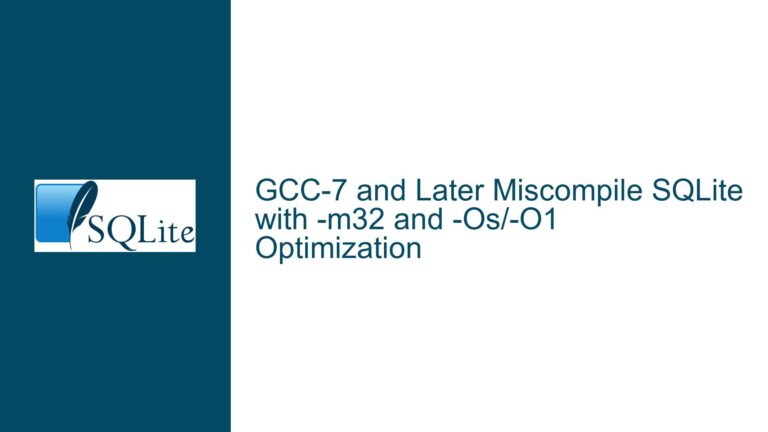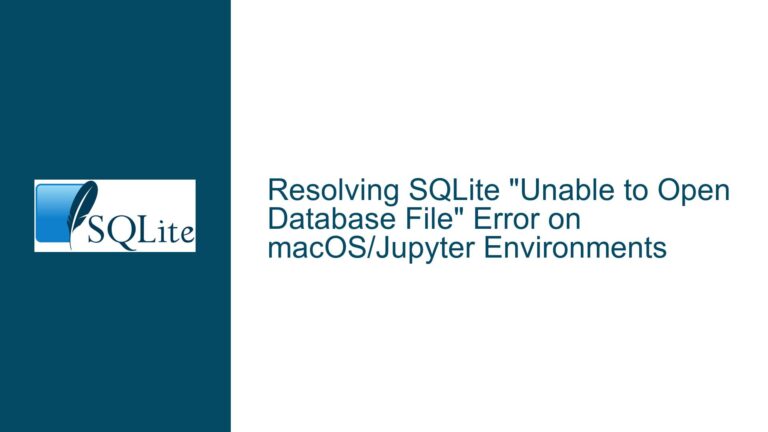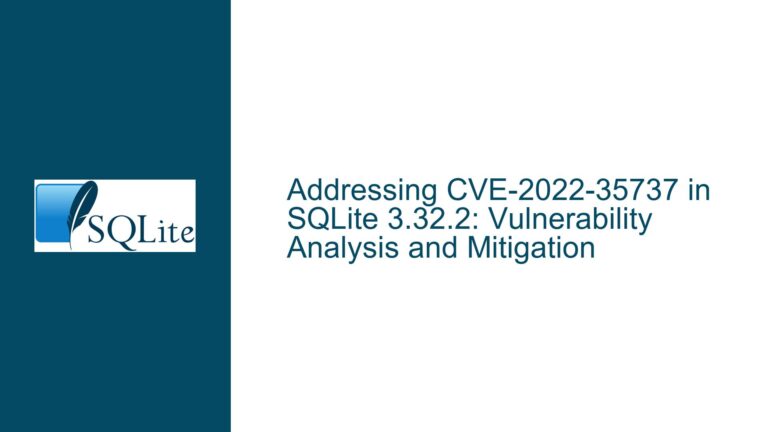Creating and Handling Malformed SQLite Databases for Unit Testing
Understanding the Need for Malformed Databases in Unit Testing
Unit testing is a critical aspect of software development, ensuring that individual components of a program function as expected under various conditions. One such condition is the handling of malformed databases, which can occur due to corruption, improper shutdowns, or software bugs. In the context of SQLite, a lightweight and widely-used database engine, developers often need to verify that their applications can gracefully handle scenarios where the database is corrupted or malformed. This is particularly important for applications that rely on SQLite for data storage, as database corruption can lead to data loss or application crashes if not handled properly.
The primary goal of unit testing in this context is to ensure that the application can detect and respond to database corruption in a controlled manner. For instance, if a database fails the PRAGMA integrity_check, the application should be able to log the error, notify the user, and potentially initiate a recovery process. However, creating a malformed database that reliably triggers these conditions can be challenging. The database must be sufficiently corrupted to fail the integrity check, but not so corrupted that SQLite rejects it outright at connection time.
Challenges in Creating Malformed Databases for Testing
Creating a malformed database that meets the criteria for unit testing involves several challenges. First, the database must be small, typically a few kilobytes in size, to ensure that it can be easily distributed and used in automated testing environments. Second, the corruption must be subtle enough to pass the initial connection checks but severe enough to fail the PRAGMA integrity_check. This requires a deep understanding of the SQLite file format and the specific checks performed during the integrity check.
SQLite performs several checks when a database is opened, including verifying the database header, checking the page size, and ensuring that the schema is correctly formatted. If any of these checks fail, SQLite will reject the database immediately, preventing further access. However, the PRAGMA integrity_check command performs a more thorough examination of the database, including checking for orphaned pages, invalid page references, and inconsistencies in the B-tree structure. To create a malformed database that fails this check but is still accessible, one must introduce subtle corruption that bypasses the initial checks but is detected during the integrity check.
Techniques for Creating Malformed Databases
There are several techniques that can be used to create malformed databases for unit testing. One approach is to manually edit the SQLite database file using a hex editor, introducing specific types of corruption that are known to bypass the initial checks but are detected by the integrity check. For example, one could modify the page header of a specific page to contain an invalid page type or corrupt the B-tree structure by altering the pointers between pages. This requires a detailed understanding of the SQLite file format and the specific layout of the database pages.
Another approach is to use SQLite’s built-in mechanisms to introduce corruption. For example, one could create a valid database and then use the VACUUM command to rewrite the database file, introducing subtle inconsistencies in the process. Alternatively, one could use the sqlite3 command-line tool to execute specific SQL statements that result in a corrupted database. For instance, one could create a table with a large number of rows and then delete a subset of those rows, leaving behind orphaned pages that are detected during the integrity check.
Validating the Malformed Database
Once a malformed database has been created, it is essential to validate that it meets the criteria for unit testing. This involves verifying that the database can be opened by SQLite without immediate errors but fails the PRAGMA integrity_check. The validation process should include the following steps:
Opening the Database: Attempt to open the malformed database using the
sqlite3command-line tool or a custom application. Ensure that the database can be opened without errors and that basic operations, such as querying the schema, can be performed.Running the Integrity Check: Execute the
PRAGMA integrity_checkcommand on the malformed database. Verify that the command returns a list of errors or inconsistencies, indicating that the database is corrupted.Testing Application Behavior: Use the malformed database in the unit test to verify that the application correctly handles the corruption. This may involve checking that the application logs the error, notifies the user, and initiates a recovery process if necessary.
Best Practices for Using Malformed Databases in Unit Testing
When using malformed databases in unit testing, it is important to follow best practices to ensure that the tests are reliable and maintainable. These best practices include:
Documenting the Corruption: Clearly document the specific type of corruption introduced in the malformed database and the expected behavior of the application in response to the corruption. This documentation should be included in the unit test code or accompanying documentation.
Automating the Test: Automate the unit test to ensure that it can be run consistently as part of the continuous integration (CI) pipeline. This may involve scripting the creation of the malformed database, running the integrity check, and verifying the application’s response.
Maintaining a Repository of Malformed Databases: Maintain a repository of malformed databases that can be used for unit testing. This repository should include databases with various types of corruption, allowing for comprehensive testing of the application’s error handling capabilities.
Regularly Updating the Tests: Regularly update the unit tests to reflect changes in the application’s error handling logic or updates to the SQLite library. This ensures that the tests remain relevant and effective in detecting issues related to database corruption.
Conclusion
Creating and handling malformed databases for unit testing is a complex but essential task for ensuring the robustness of applications that rely on SQLite. By understanding the challenges involved, employing appropriate techniques for introducing corruption, and following best practices for testing, developers can create reliable unit tests that verify their application’s ability to handle database corruption gracefully. This not only improves the overall quality of the software but also enhances the user experience by preventing data loss and application crashes in the event of database corruption.
Possible Causes of Database Corruption in SQLite
Database corruption in SQLite can occur due to a variety of reasons, ranging from hardware failures to software bugs. Understanding these causes is crucial for both preventing corruption and creating effective unit tests that simulate real-world scenarios. Some of the most common causes of database corruption in SQLite include:
Hardware Failures: Hardware failures, such as power outages or disk errors, can lead to database corruption. When a power outage occurs, the database may be left in an inconsistent state if the write operations were not completed. Similarly, disk errors can result in corrupted data being written to or read from the database file.
Software Bugs: Bugs in the application or the SQLite library itself can cause database corruption. For example, a bug in the application’s logic for writing data to the database could result in invalid data being stored, leading to corruption. Similarly, a bug in the SQLite library could cause it to mishandle certain operations, resulting in a corrupted database.
Improper Shutdowns: Improper shutdowns of the application or the system can lead to database corruption. If the application is terminated abruptly while it is in the middle of writing data to the database, the database may be left in an inconsistent state. Similarly, if the system is shut down without properly closing the database, corruption can occur.
File System Issues: Issues with the file system, such as file system corruption or incorrect permissions, can lead to database corruption. For example, if the file system becomes corrupted, the database file may be partially overwritten or truncated, resulting in a corrupted database. Similarly, if the application does not have the correct permissions to write to the database file, it may result in incomplete or incorrect data being written.
Concurrency Issues: Concurrency issues, such as race conditions or deadlocks, can lead to database corruption. If multiple processes or threads are accessing the database simultaneously without proper synchronization, it can result in inconsistent data being written to the database. For example, if two processes attempt to write to the same page of the database at the same time, it could result in a corrupted page.
File Transfer Errors: Errors during file transfer, such as network interruptions or incomplete downloads, can lead to database corruption. If the database file is being transferred over a network and the transfer is interrupted, the file may be incomplete or corrupted. Similarly, if the file is downloaded from a remote server and the download is incomplete, the database may be corrupted.
Malicious Activity: Malicious activity, such as hacking or malware, can lead to database corruption. If an attacker gains access to the database file, they may intentionally corrupt the data to disrupt the application or steal sensitive information. Similarly, malware on the system may modify the database file, resulting in corruption.
Troubleshooting Steps, Solutions & Fixes for Handling Malformed Databases
When dealing with malformed databases in SQLite, it is important to have a systematic approach to troubleshooting and resolving the issues. The following steps outline a comprehensive process for identifying, diagnosing, and fixing problems related to malformed databases:
Identify the Symptoms: The first step in troubleshooting a malformed database is to identify the symptoms of the corruption. This may include error messages when opening the database, unexpected behavior when querying the data, or failures during the
PRAGMA integrity_check. By understanding the symptoms, you can narrow down the potential causes of the corruption and determine the appropriate course of action.Run the Integrity Check: The next step is to run the
PRAGMA integrity_checkcommand on the database. This command performs a thorough examination of the database and reports any inconsistencies or errors. The output of the integrity check can provide valuable insights into the nature and extent of the corruption. For example, if the integrity check reports orphaned pages or invalid page references, it indicates that the B-tree structure of the database is corrupted.Analyze the Integrity Check Results: Once the integrity check has been run, analyze the results to determine the specific issues with the database. This may involve reviewing the error messages, examining the database schema, and inspecting the data within the database. By understanding the specific issues, you can develop a targeted approach to resolving the corruption.
Backup the Database: Before attempting any repairs, it is essential to create a backup of the corrupted database. This ensures that you have a copy of the original data in case the repair process results in further corruption or data loss. The backup can be created using the
.backupcommand in thesqlite3command-line tool or by copying the database file to a secure location.Attempt to Repair the Database: Depending on the nature and extent of the corruption, there are several approaches to repairing the database. One approach is to use the
VACUUMcommand, which rebuilds the database file and removes any orphaned pages or inconsistencies. Another approach is to use theREINDEXcommand, which rebuilds the indexes in the database and can resolve issues related to invalid index entries. If these commands are not sufficient, you may need to manually repair the database using a hex editor or a specialized tool.Restore from Backup: If the corruption is severe and cannot be repaired, the next step is to restore the database from a backup. This involves replacing the corrupted database file with a previously created backup and verifying that the data is intact. It is important to ensure that the backup is up-to-date and contains all the necessary data to avoid data loss.
Implement Preventive Measures: Once the database has been repaired or restored, it is important to implement preventive measures to avoid future corruption. This may include improving the application’s error handling logic, implementing proper synchronization for concurrent access, and regularly backing up the database. Additionally, you should monitor the database for signs of corruption and address any issues promptly to prevent further damage.
Test the Application: After resolving the corruption, it is essential to test the application to ensure that it can handle similar issues in the future. This may involve running unit tests with malformed databases, simulating hardware failures, and testing the application’s response to various error conditions. By thoroughly testing the application, you can verify that it is robust and resilient to database corruption.
Document the Incident: Finally, document the incident, including the symptoms, causes, and resolution of the corruption. This documentation can serve as a reference for future troubleshooting and help other developers understand how to handle similar issues. Additionally, it can provide valuable insights into potential weaknesses in the application or the database design that should be addressed to prevent future corruption.
Conclusion
Handling malformed databases in SQLite requires a combination of technical expertise, systematic troubleshooting, and preventive measures. By understanding the causes of database corruption, employing appropriate techniques for creating malformed databases, and following best practices for testing and maintenance, developers can ensure that their applications are robust and resilient to database corruption. This not only improves the overall quality of the software but also enhances the user experience by preventing data loss and application crashes in the event of database corruption.






